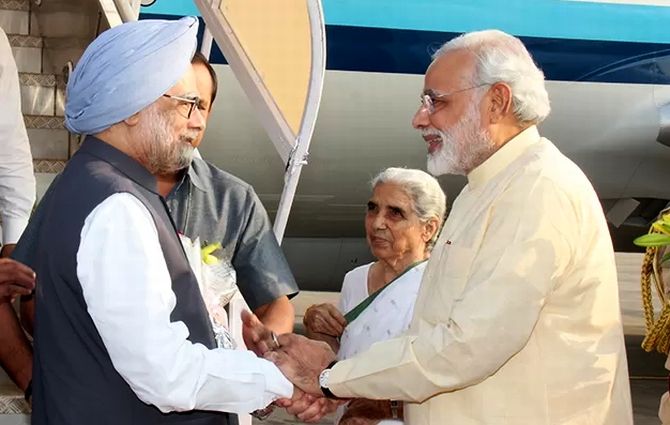If the PM wishes to be re-elected in 2019, there are a few things he needs to learn from his predecessor

Six years ago, I wrote an article asking what lessons Manmohan Singh could learn from Narendra Modi. Now the time has come to reverse that question: what lessons can Modi learn from Manmohan Singh?
Modi has a primary goal, to which all other goals are subordinated: re-election in 2019. To achieve it, he has adopted a project implementation approach.
This is the opposite of the United Progressive Alliance approach, which focused mainly on policy and neglected project implementation. Aadhar and MNREGA were exceptions because of the obvious political returns they promised.
But, as economists like to say, while both approaches are necessary; neither is sufficient. But together they do become largely sufficient.
This means that unless the PMO stops confusing state policy with project implementation the chances of re-election will be vastly reduced. It will have only itself to blame then.
I tried explaining this to a “friend” of the Modi government and was rewarded with a look of utter incomprehension. I then suggested to him that while the project approach was fine in the early days, when it’s messaging required the government to convey that it meant business, the time had come to move on.
I got a blank stare again.
And, there, perhaps lies the biggest weakness of this government: it is unable to tell the difference between the Gujarat model and a national model. But what worked in Gujarat will not, by itself, work at the all-India level.
Modi ought to realise this quickly.
Shift focus
If he wants to get re-elected in 2019, he needs to shift his focus immediately. He can do that by studying UPA-I’s performance closely.
That had three major components: low inflation, high investment, and huge income transfers to rural areas.That was policy. Manmohan Singh was responsible for the first two; Sonia Gandhi and the National Advisory Council for the third.
Inflation during the five years of UPA-I, aided by international factors, averaged six per cent. More importantly, until 2008 it was below five per cent.
The savings (investment) rate averaged 32 per cent. Around 80 per cent went into private corporate investment. The government took a back seat.
And income transfers to rural India (through subsidies, MNREGA, and loan waivers) added up to about Rs 500,000 crore, most of it in during 2006-08. In those pre-2008-11 stimulus days, that was a lot of money.
Within overall inflation, what really helped the voter-consumer feel very good was low food inflation. Between 2004 and 2008, it was below five per cent. It went beyond seven per cent from the latter half of 2008.
Currently, it is running at six per cent -- but that comes on top of the 65 per cent increase in food prices between 2009 and 2014. Result: the voter/consumer is still feeling poor.
Likewise, the savings rate in 2004 was 29 per cent. By 2009, it had climbed to 34 per cent. This translated into more work, if not more jobs. Again the voter-consumer felt good.
But what really helped the UPA in 2009 was the huge injection of money into rural India from 2005 to 2009. It came via steady annual increases in the Minimum Support Price for wheat and paddy, which turned the terms of trade in the farmers’ favour for the first time since 1996. This was accompanied by huge subsidies. Finally, in 2008, came the Rs 60,000-crore loan waiver.
After that, although even the UPA didn’t see the win coming, the BJP had no chance.
Two-and-a-half suggestions
If the above thesis is accepted, at least in its broad contours, Modi has three clear targets to aim at: bring food inflation down to three per cent; raise the savings rate to 35 per cent; and effect huge income transfers to rural areas to re-energise aggregate demand.
The last is the easiest and politically most attractive especially as he is being accused of heading a ‘suit-boot ki sarkar’. Indeed Modi has already said MNREGA will continue -- with more money. Nor is he about to start reducing subsidies.
Only loan waivers -- another form of direct cash transfers -- are left. Those will come.
Food inflation is harder to solve when the number of net buyers of food is increasing because of urbanisation and landlessness. It calls for large-scale imports.
Luckily, the fall in global oil prices gives Modi room. These imports should be tied to food processing industries to take them out of the domestic market.
As to raising the savings (investment) rate, it can be done by creating a new class of income tax payers -- self-employed professionals -- who file under Form 16A. They need to convert a portion of their current income to a stream of future income, for which no decent instruments are available. So they invest in gold or real estate.
This expanding group formed the backbone of Modi’s support in 2014 and still does. For them, a special, inflation-indexed, non-tradable bond must be created. The amount invested in these bonds should be reduced from the final tax payable. These bonds may also help reduce cash transactions in this class of taxpayers.










